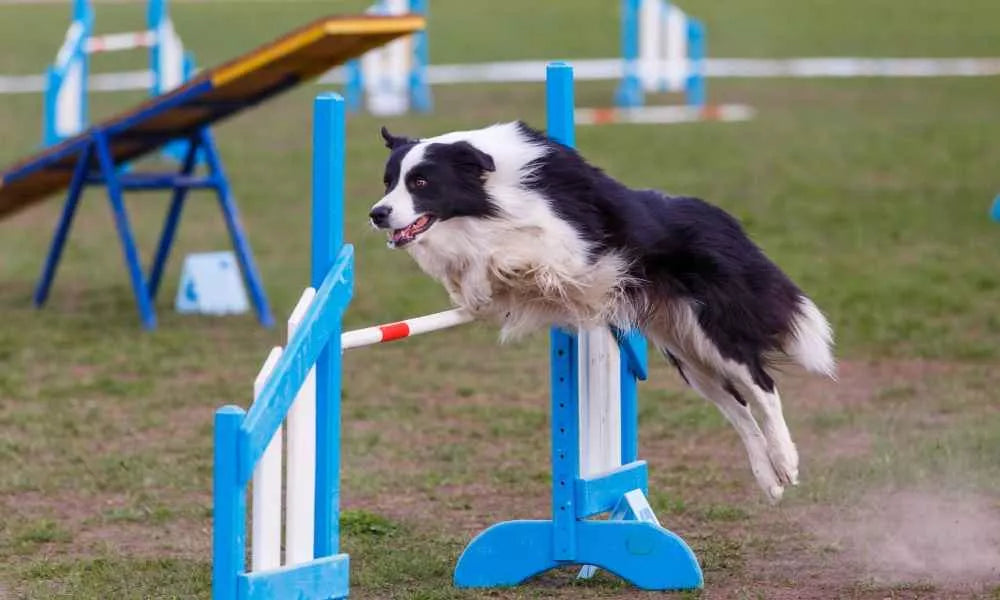Is Dog Agility Training Safe For My Dog

A lot of people think that dog agility training can be quite brutal. Well, that maybe true for the adults but not so much for the dogs.
Of course, there are exceptions to this, especially for dogs with weak limbs and those suffering with conditions like hip dysplacia or arthritis.
You should also avoid full on agility activities if your dog is younger than 1 year old. Bones do not fully develop in a small dog until they are around 1 year old and this can be up to 18 months in larger breeds. So, all we ask is that you introduce your dog to agility training slowly, especially if they are only 12 to 18 months old.
So why is agility training so great for you and your dog?
It is not only a great form of exercise, but it gets you socialising with like-minded dog owners. It is usually a relaxed atmosphere (if you pick the right club) and most people and their dogs are just there to have fun.
One of the most important things to remember is that agility training and activities gives you and your dog the opportunity to build a common language and strong bond. It can stimulate your dog's brain more than any hour of mad running around could do and this is all down to how the dog must react to commands and act on those to achieve a goal and praise from their owner. This combination creates a fantastic environment to challenge your dog and this is what they need. They want to work, they want to please you and they want to have fun.
So as you can see, the socialising doesn't stop with the adults - your dogs get a huge amount out of it in this area too. There are so many benefits and some will strike a chord more than others. This very much depends on how your dog currently reacts around people and other dogs and if it has any issues with anxiety or other behavioural problems.
The fact is that agility activities can help to solve and cure developed and inherent problems in dogs - period. It really is that good! Try it, stick with it and tell me if you don't think your dog's behaviour has improved (if this is an issue) or that it doesn't seem happier.
So what is an agility course?
An agility course is basically a series of obstacles. You and your dog must follow a predetermined set of jumps, weaves, tunnels and other various challenges. The list of obstacles can vary from course to course, as too can the level of difficulty and complexity.
Before you run the course with your dog, you'll get the chance to do a walk through and this will help you to familiarise yourself with the set up, placement and order in which to tackle the obstacles. The objective here is to get a clear understanding of the course so you can plot and plan the best way in which to approach each jump, tunnel or other challenge.
Some people will take it more seriously than others and from a personal perspective, our main aim was to register with a club that had a very friendly and laid back attitude. As it turned out this particular club used an outside course in the summer and then a smaller indoor one in the winter. Our dog was not too keen on the indoor one so we only used the facilities in the lighter months.
It is important for you and your dog to enjoy the experience. If you can both do this, I cannot shout loudly enough about the advantages of using agility training as a way to bond and get even closer to your dog. If you and your dog take to it (and enjoy it) it can have tremendous benefits for you and your dog's fitness, as well as providing mental stimulation.
Agility dog training is a very safe and worthwhile activity, as long as you train your dog slowly and allow it to adapt and react to obstacles in their own time.
In the video above, you'll see our boy having one of his first journey's around an agility course. This shows him getting use to the course and each obstacle in a very slow and controlled way. It is at this time that the dog will tell you if he/she doesn't like a particular part of the course. Some dogs have issues with apparatus like the A frame and see-saw, so it is very important that you show encouragement with a little force and persistence, but allow the dog to get to grips with each element.
In contrast the video below shows our boy after a fair bit of training. When he knows it is his turn he will literally drag us into the ring to get started and gets very excited when he has completed it. This is because we show him that he has done well, through praise and this pleases him even more. You'll see on the third run that he nails it.
Please believe us when we say that we are careful and considerate owners and we would not do anything if it could potentially cause harm or serious injury to our dogs. As with any activity or sport there is a small risk of injury, but in our opinion the positive aspects of agility training far outweigh any negative ones.





